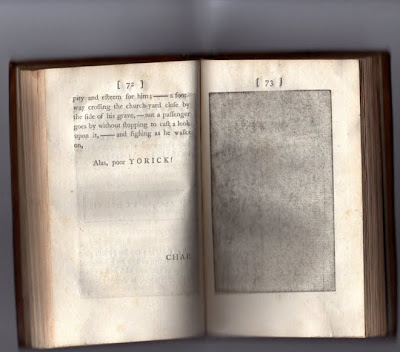 Black Page 73 by Patrick Hughes
Black Page 73 by Patrick HughesIn celebration of the 250th anniversary of the publication of the first edition of Tristram Shandy, Shandy Hall, author Laurence Sterne’s former home in Coxwold, U.K, has mounted an exhibition, The Black Page.
Seventy-three artists, composers and writers have created their own interpretations of the infamous Black Page, using a sheet of A4 handmade Somerset paper that Incline Press has printed with the outline of the original page in true proportion and the number “73.”

“At the end of volume 1, chapter 12 [pp. 73] of his comic masterpiece, Laurence Sterne famously confronts his readers with a page completely coated on both sides in pure black ink. The most memorable oddity in a book filled with memorable oddities, the black page marks the first death in Tristram Shandy, that of Parson Yorick, Sterne’s whimsical, laughter-loving innocent…
“…Yorick acquires enemies even more quickly than he can produce bons mots, until at last the knaves confederate and exact their revenge by attacking Yorick in the press—slandering his character, questioning his faith, distorting his writings, trampling his learning, and burying every trace of his troublesome wit. Wearied by this war of words, Yorick finally ‘threw down the sword; and though he kept up his spirits in appearance to the last,——he died, nevertheless, as was generally thought, quite broken hearted.’ ‘Alas, poor YORICK!’ Tristram cries —and then his startling gesture of absolute opacity.
“Haunting in its strangeness, Sterne’s famous black page offers a particularly dense example of a rhetorical formation that I would like to call “sentimental irony,” irony and sentimentality placed in a mutually constitutive, dialogical relationship. The black page’s sentimental appeal both deepens and complicates—and is in turn deepened and complicated by—its ironic implications. An overflow of ink, the black page seems to record Tristram’s overflow of feeling at Yorick’s death. It is as if, overwhelmed by the task of conveying his sentiments on Yorick’s demise, Tristram tries to say everything at once—and therefore can say nothing at all. The black page thus takes to its absolute limit the inexpressibility topos that is the hallmark of sentimental rhetoric: the formula “words cannot convey what I then felt” surely finds here its most extreme expression” (Kim, James. “Good Cursed, Bouncing Losses”: Masculinity, Sentimental Irony, and Exuberance in Tristram Shandy. The Eighteenth Century, vol. 48, no. 1, 2007, p. 3).
Here are a few examples:
Black Page 46 and Black Page 65
Black Page 71 and Black Page 50
Black Page 25 and Black Page 16
The exhibition runs through October 31, 2009.
A tip o’ the hat to Black Page Blogspot.
___________
STERNE, Laurence. The Life and Opinions of Tristram Shandy, Gentleman… York, 1759 (Volumes 1&2). Lowndes 3, p. 2510.







